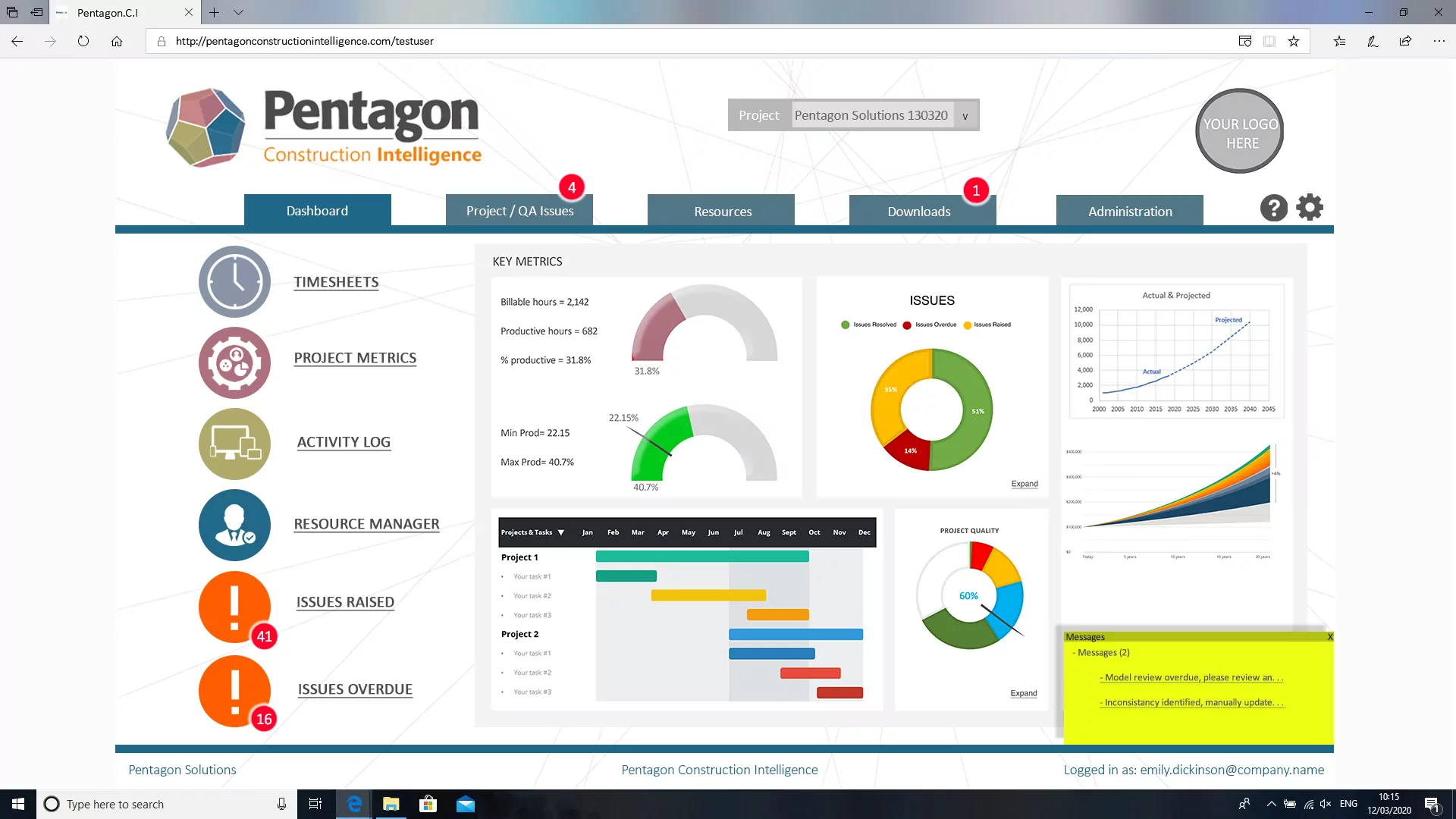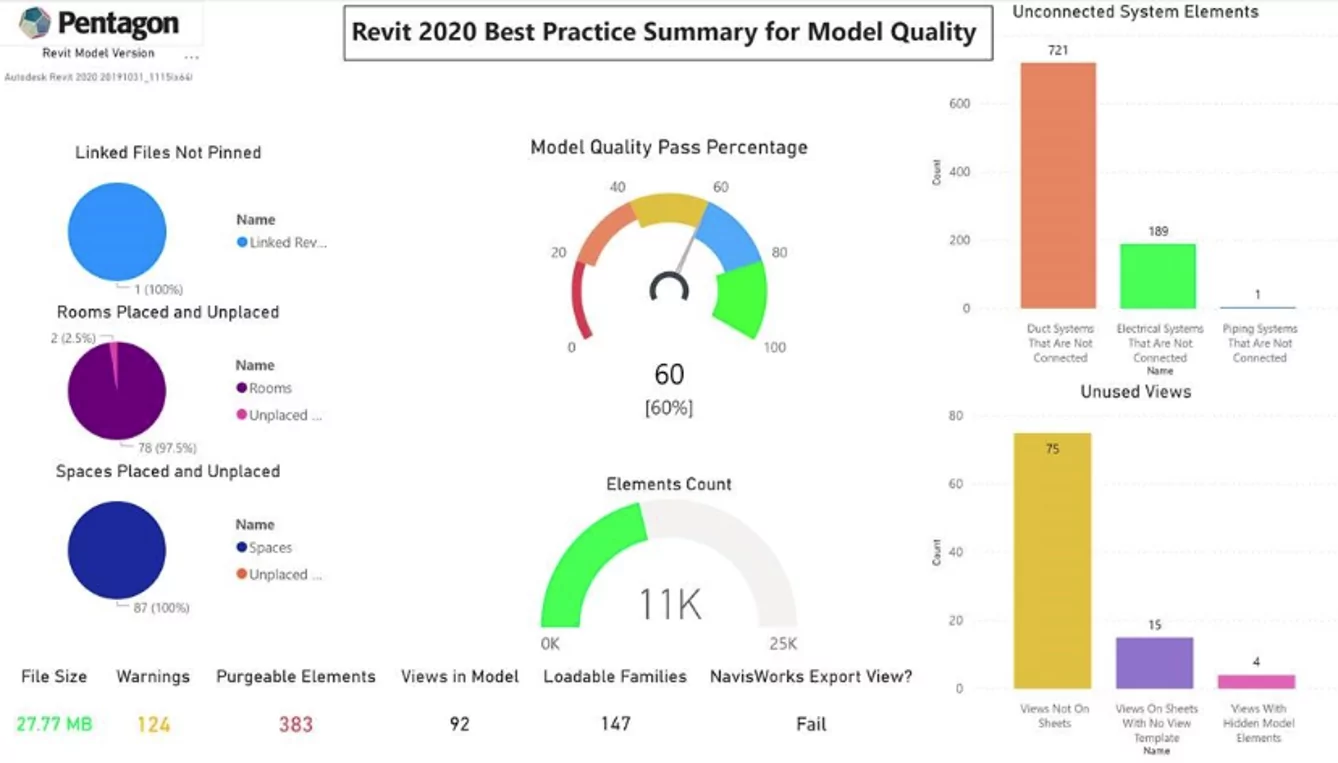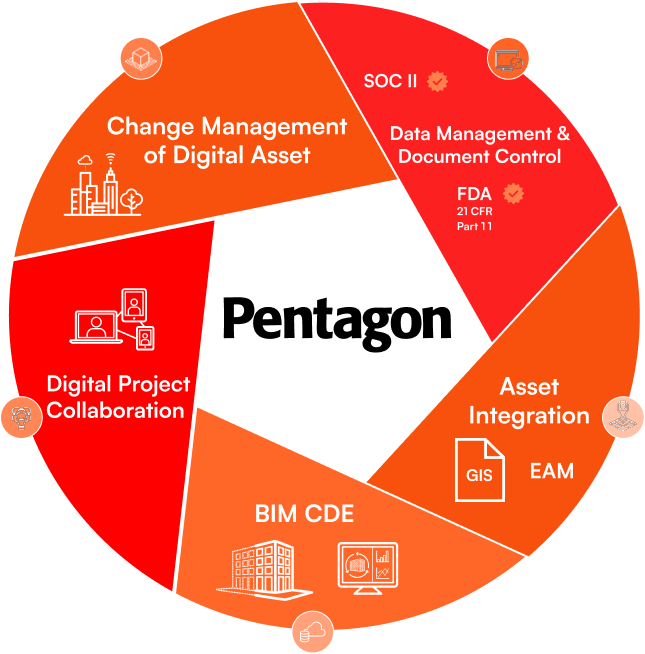Home
Construction Intelligence
Construction Intelligence
Change the way you use data to run your built environment.
By delivering data-led intelligence we can transform the way your people and systems work together and help you drive the business forward.
Pentagon’s Construction Intelligence
Pentagon has conducted extensive research whilst implementing a Construction Intelligence framework process, delivering asset integration projects based on this method.
We find that many contractors have a lack of visibility on project delivery and aggregate information from multiple sources. As an example: team timesheets, estimated detailing and modelling activity, quality of model delivery, etc.
For efficient project management within the built environment, multiple streams of information need to be centralised – that’s where Construction Intelligence comes in. Essentially it addresses project quality, productivity outputs, and risk management and can assist in predictability for future projects, regardless of technology.
“Construction Intelligence overcomes a segmented manual or semi-automated engineering process, which in turn causes data silo’s, project over-runs and eventually indecision by key stake holders…. Which in turn causes massive inefficiencies during the project or when tendering for new business. ”

Through our platform, all issues and project constraints can be recorded and collected in the dashboard, ensuring efficient oversight that can easily identify risk. Our solution is scalable to your business, it relies on human (user) input and is completely flexible to accommodate your operation.
With visual measures and automated solutions, our Construction Intelligence platform allows you to track progress, anticipate risks and ensure effective project management.
Pentagon Construction Intelligence Interface
Empowering the construction industry with cutting-edge technology, our Construction Intelligence Interface is user-friendly and designed to streamline operations and enhance project outcomes.
This interface offers a comprehensive suite of features that provide company-wide visibility, facilitate multi-user data logging, and enable seamless updates to quality issues and constraints.
Here’s a closer look at what our Construction Intelligence Interface provides:
- Company-wide visibility of BIM Project data for quality, constraints, dashboards and other bespoke utilities
- Multi-user data logging forms and
- Allows updates to Quality Issues and Constraints without the need for CAD applications
- Reports presented (e.g. Microsoft PowerBI)
- Other Features
- Project-specific data segregation
- Integrates with Microsoft Azure single sign-on
How does it work?
Traditionally your teams fill out timesheets on projects they are working on and they may manually estimate modelling output. All of this data is normally reviewed on an individual basis.
Our solution captures and harvests all activity automatically from projects, drawings and models across all teams over multiple sites. All of the project data is automatically collated regarding activity and outputs.

This centralised data is presented through straightforward dashboards for project team leaders and senior management. Project modelling outputs, quality and effort data points are readily available which helps teams to focus on productivity concerns and even drive predictability of project delivery or assist with pricing future projects.
Benefits of the Pentagon Construction Intelligence Platform
Construction Intelligence is important for several reasons, it brings numerous benefits to the construction industry, enhancing the overall efficiency, quality, and sustainability of construction projects.
Here are some reasons why our platform stands out.
- Turns information from subjective into objective – makes it measurable.
- It is an automated, accurate method of capture – minimal user or management input
- Construction & Contractor Intelligence Solution
- Bespoke – Customer-Centric Interface & Function
- Software Agnostic – Integrates with Industry or Customer Applications
- Defined Metrics and Dashboarding
- Cloud-based
The Pentagon Construction Intelligence Platform is a revolutionary tool designed to optimise the construction industry by transforming subjective information into objective, measurable data.
The platform is characterised by its bespoke, customer-centric interface and functionality, and its software-agnostic nature, allowing seamless integration with various industry or customer applications.
Fill out the form for more information or chat with the team about defining your metrics:
What Does Construction Intelligence Provide?
Construction Intelligence refers to the use of data, analytics, and technology to gain insights and make informed decisions in the construction industry. It involves the collection, analysis, and use of data to improve efficiency, reduce costs, and enhance the overall performance of construction projects.
Here are several aspects of Construction Intelligence:
Data Collection and Analysis:
- Collecting data from various sources such as sensors, machinery, and project management software.
- Analysing this data to identify patterns, trends, and insights that can inform decision-making.
Project Management:
- Using intelligent tools and software to manage project schedules, budgets, and resources more effectively.
- Predicting and mitigating risks and delays through data analysis.
Building Information Modeling (BIM):
- Creating digital representations of the physical and functional characteristics of buildings.
- Using BIM models to enhance collaboration, design optimisation, and construction planning.
Machine Learning and AI:
- Implementing machine learning algorithms and AI to predict outcomes, optimise processes, and automate tasks.
- Using AI for design optimisation, cost estimation, and risk management.
Internet of Things (IoT):
- Utilising IoT devices and sensors to monitor construction sites, equipment, and worker safety.
- Collecting real-time data for analysis and decision-making.
Supply Chain Optimization:
- Leveraging data and analytics to optimise the construction supply chain.
- Improving procurement processes, inventory management, and logistics.
Sustainability and Environmental Impact:
- Analysing environmental data to minimise the ecological footprint of construction projects.
- Implementing sustainable practices and materials based on data insights.
Safety and Compliance:
- Monitoring and ensuring compliance with safety regulations and standards.
- Using data to identify and mitigate safety risks on construction sites.
Cost Estimation and Budgeting:
- Utilising data and algorithms to accurately estimate costs and manage budgets.
- Identifying cost-saving opportunities through data analysis.
Performance Monitoring:
- Tracking the performance of construction projects against key performance indicators (KPIs).
- Using performance data to make adjustments and improvements.
By leveraging Construction Intelligence, companies in the construction industry can enhance productivity, reduce costs, improve safety, and deliver projects on time and within budget.
Why Invest in Construction Intelligence?
Investing in Construction Intelligence is crucial in order to remain competitive within the construction industry. It will allow for better project management, maximise energy and resources and ultimately generate better profits.
Here are a few reasons why you should invest in Construction Intelligence.
Efficiency and Productivity
- Construction Intelligence enables better planning, scheduling, and resource allocation, leading to increased efficiency and productivity on construction sites.
- Automation of routine tasks and processes reduces manual labour and accelerates project timelines.
Cost Savings:
- Accurate cost estimation and budgeting help in avoiding cost overruns and ensuring financial viability.
- Data-driven insights allow for the identification of cost-saving opportunities and optimization of the supply chain.
Risk Mitigation:
- Predictive analytics and real-time monitoring help in identifying and mitigating risks early, preventing delays and additional costs.
- Enhanced safety monitoring reduces the likelihood of accidents and ensures compliance with safety regulations.
Quality Improvement:
- Data analysis and Building Information Modeling (BIM) contribute to better design and construction quality.
- Continuous monitoring and feedback loops enable adjustments and improvements throughout the project lifecycle.
Decision-Making:
- Access to accurate and timely data supports informed decision-making at all stages of a construction project.
- Data visualisation and reporting tools facilitate better communication and collaboration among stakeholders.
Innovation:
- The adoption of new technologies such as AI, IoT, and drones fosters innovation in construction methodologies and practices.
- Innovation leads to the development of new solutions to address challenges in the construction industry.
Competitive Advantage:
- Companies that leverage Construction Intelligence can differentiate themselves in the market by delivering high-quality projects on time and within budget.
- Early adopters of intelligent technologies gain a competitive edge and can secure more business opportunities.
Customer Satisfaction:
- Meeting or exceeding project expectations in terms of quality, cost, and timeline leads to higher customer satisfaction.
- Satisfied customers are more likely to return for future projects and recommend the company to others.
Regulatory Compliance:
- Ensuring compliance with local, regional, and international construction standards and regulations is essential.
- Construction Intelligence helps in monitoring and documenting compliance, avoiding legal issues and penalties.
By addressing these aspects, Construction Intelligence contributes to the overall advancement of the construction industry, making it more resilient, adaptable, and future-ready.
Ask the team a question

- Harvest multiple Data Streams – usually data silos
- Amalgamate into a central location.
- Categorize, analyze and report on.
- User activity (Individual – Grouped).
- User KPI’s
- Software usage
- Data being worked on – duration of work
- Harvest multiple Data Streams – usually data silos
- Amalgamate into a central location.
- Categorize, analyze and report on.
- User activity (Individual – Grouped).
- User KPI’s
- Software usage
- Data being worked on – duration of work
- Navisworks Integration